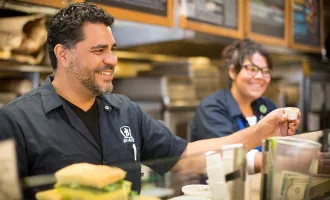Gathering Wild Edibles: Start with Nasturtium
What would you do if the food supply chain failed you tomorrow? In modern society, only a small minority of people know how to grow, hunt or gather their own sustenance. If you haven’t noticed the harbingers of decline, let me be the first to tell you: The empire is crumbling!
If the grocery stores were scoured clean by hungry mobs, would you be able to find food, right here in the urban jungle of San Francisco?
I’ve recently begun researching and experimenting with local edible wild plants. The best way to learn about a plant is to taste it.
Sure, you start with a plant identification book or some botany website, but once you’re pretty certain that what you’ve found is edible, you then must apprehend it with our great under-utilized survival skill: the sense of taste.
Somehow the memory of the plant that has been chewed, swallowed and incorporated into our physical selves is indelible. I will remember forever the first time I ate a nasturtium.
If you tell a long-time San Francisco plant-lover that you’re interested in wild edibles, the first thing everyone will say is, “Nasturtium!”
With round green leaves and matching round orange flowers, it can be found in great abundance on nearly every street in the Sunset. It blankets great shady sections of Golden Gate Park and tumbles down the steep western slopes of Mount Sutro, which is where I first put its delicate leaves to my foraging lips.
All parts of the plant — leaves, flowers, seeds and stems — are edible and even delicious, with a spiciness not unlike arugula. Raw, the flowers make a colorful, if calorically insignificant, contribution to a salad.
The seeds are often pickled and used as a caper substitute. Gathered in bulk, the leaves can function like spinach in any recipe. I sautée mine in chilaquiles, with eggs, salsa and day-old corn tortillas.
The name nasturtium is a bit of a misnomer, as that term, strictly speaking, refers to the watercress genus, some members of which are similar to our local so-called nasturtium in both appearance and edibility.
The true Latin name of our local leafy green is Tropaeolum majus. It is native to the Andes, from Bolivia to Colombia, but has been introduced around the world for its beauty and taste.
For the budding botanists out there, here is the detailed Wikipedia description: “It is a herbaceous annual plant with trailing stems growing to 1 meter (3 feet, 3 inches) long or more. The leaves are large, nearly circular, 3 to 15 centimeters (1.2 to 5.9 inches) in diameter, green to glaucous green above, paler below; they are peltate, with the 5 to 30 centimeter-long petiole near the middle of the leaf, with several veins radiating to the smoothly rounded or slightly lobed margin. The flowers are 2.5 to 6 centimeters in diameter, with five petals, eight stamens, and a 2.5 to 3 centimeter-long nectar spur at the rear; they vary from yellow to orange to red, frilled and often darker at the base of the petals.”
Gathering wild foods will forever change the way you look at plants. What was once just a bunch of green things will unfold into a beautifully complex and beneficently bountiful world.
Knowledge of the edible morsels therein used to be universal and fundamental for all humans; now nearly all of us, even the farmers, are oblivious to it. There are hundreds of wild plants in this city alone, which might someday sustain you. Start with nasturtium, and happy foraging!


